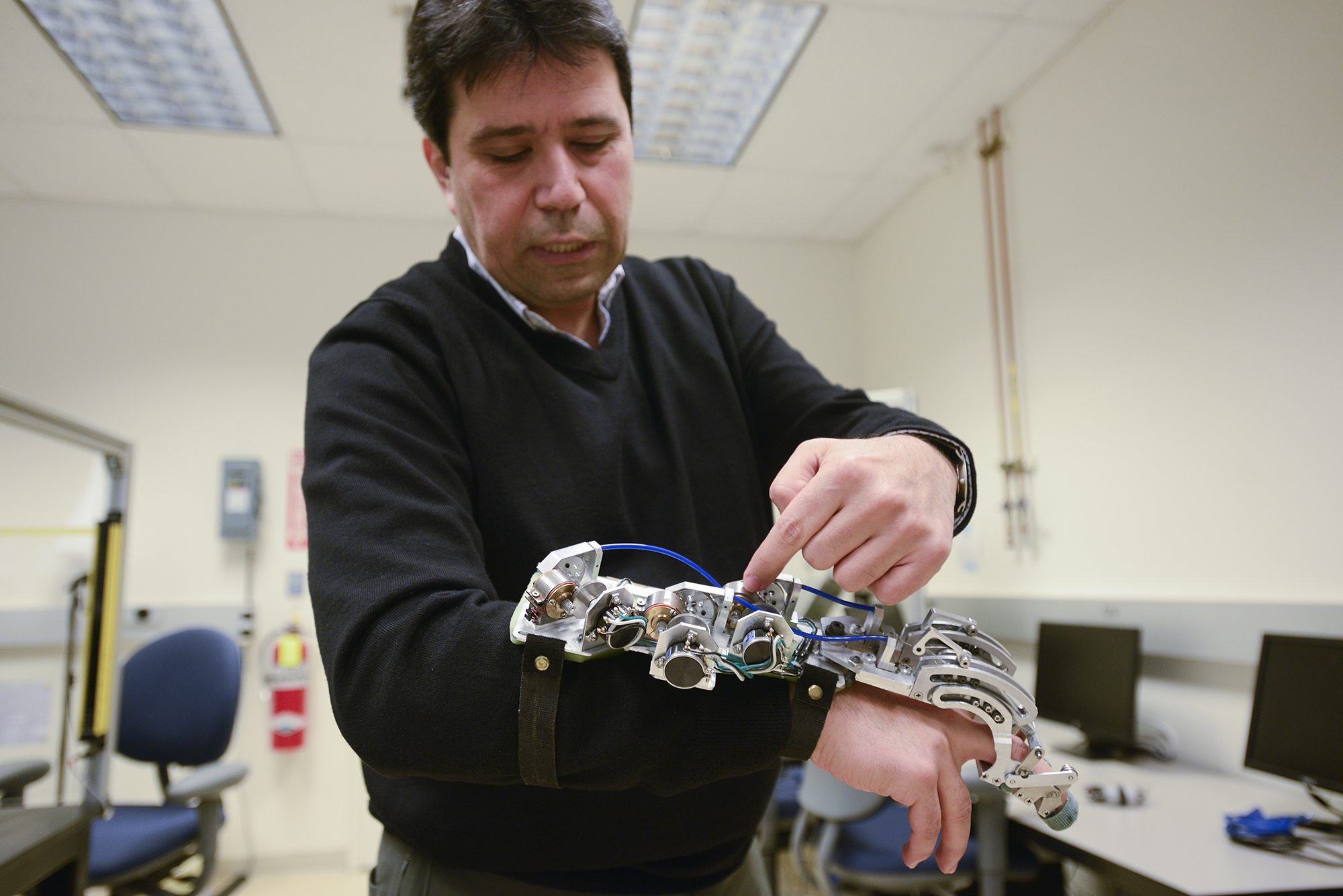Hakan Gurocak slid his right hand into a futuristic-looking metal glove in an engineering lab at Washington State University Vancouver. The glove could be a prop in the new sci-fi “Star Wars” movie. But it’s not a prop.
The glove uses haptic technology, and by wearing it and special goggles, a person can experience a realistic sense of touch while interacting with virtual objects. Haptic sensations are created by actuators — motors, electronic brakes and pneumatic systems — which apply forces, vibrations or motions to the user.
For decades, engineers around the world have been developing haptic technology. It has been implemented in the medical, dental, automotive and video gaming fields, among others.
Haptic technology makes it possible for luxury automobile engineers to sit in a virtual car and “feel” the steering wheel, interact with the dashboard controls and determine which design modifications they should make before they build an actual car.
Haptic Technology
• What is it? The science of creating a realistic sense of touch and force feedback while interacting with virtual objects.
• How does it work? Haptic sensations are created actuators —motors, electronic brakes and pneumatic systems — which apply forces, vibrations or motions to the user.
• Derived from: The word “haptics” is derived from the Greek word “haptkos,” which means to grasp or perceive.
Gurocak, an engineering professor and director of the School of Engineering and Computer Science, has been working with a team of graduate students on developing the technology for 14 years. Recently he was granted two patents for his work in the haptic field. He is the only WSU Vancouver professor to hold a U.S. patent.
The first patent is to help develop an electronically controlled brake that cancels magnetic memory. Before Gurocak’s discovery, the technology developed magnetic memory that thwarted a realistic virtual experience. For example, if the user picked up a virtual coffee cup, when he set the cup down on the virtual table, the user would still feel he was holding the cup.
Since the 1950s, engineers have been working on a solution to the magnetic memory problem. While working on another problem, Gurocak and his students “ran into the solution of how to erase magnetic memory.”
They solved the problem by embedding a sensor that turns off the magnetic memory. It wasn’t an expensive fix either. The sensor cost about $1.75.
The second patent is for an improved internal design for more powerful actuators that are much smaller. One challenge is to build a haptic glove that’s not enormous, heavy or bulky. It’s challenging to apply a big force in a small size, he said. The earlier haptic gloves were much bulkier and heavier, but as technology improves, the gloves are becoming lighter and less cumbersome. His second patent will allow for a smaller, more user-friendly glove.
The patents most likely will be used in a glove similar to the one Gurocak wore in the engineering lab. The patents will improve the user’s virtual experience, make the action feel more lifelike and likely will be used in many applications.
Future of haptics
Gurocak surmised future applications for haptics as engineers continue improving the technology. For instance, he believes that someday an online shopper will be able to touch the virtual shirt on the computer screen and feel the weight and texture of the fabric.
Currently, thousands of surgical robots are being used at hospitals around the world, including Legacy Salmon Creek Medical Center near the WSU Vancouver campus. Gurocak has observed a surgery in which the surgeon wearing a haptic glove is holding surgical instruments and peering into a screen. His movements control a robot that is making the actual incisions into the patient. Robotic arms are the size of a human finger, so that the incisions into the patient are much smaller. But there’s a major drawback.
“The down side is there’s no sense of touch,” Gurocak said. “The surgeon can’t feel the tissue. Am I touching bone? Is it soft tissue? Healthy tissue? A tumor?”
As the technology improves, the virtual experience will be enhanced, he said.
On the patent application, Gurocak listed his former graduate students as co-inventors. Doruk Denkal, Berk Gonenc and Mustafa Alkan worked alongside their teacher. The first two men pursued Ph.Ds. Alkan started a company in his native Turkey. Randy Bullion, another former graduate student, built the haptic glove Gurocak demonstrated.
Gurocak’s former students have become the next generation of innovators creating revolutionary products that are becoming reality, he said.
“I’m very proud,” he said. “Their years of hard work have paid off.”




